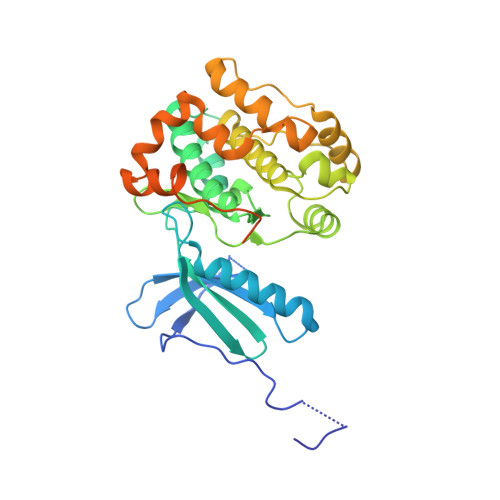NEK1 kinase domain structure and its dynamic protein interactome after exposure to Cisplatin.
Melo-Hanchuk, T.D., Slepicka, P.F., Meirelles, G.V., Basei, F.L., Lovato, D.V., Granato, D.C., Pauletti, B.A., Domingues, R.R., Leme, A.F.P., Pelegrini, A.L., Lenz, G., Knapp, S., Elkins, J.M., Kobarg, J.(2017) Sci Rep 7: 5445-5445
- PubMed: 28710492
- DOI: https://doi.org/10.1038/s41598-017-05325-w
- Primary Citation of Related Structures:
4APC, 4B9D - PubMed Abstract:
NEK family kinases are serine/threonine kinases that have been functionally implicated in the regulation of the disjunction of the centrosome, the assembly of the mitotic spindle, the function of the primary cilium and the DNA damage response. NEK1 shows pleiotropic functions and has been found to be mutated in cancer cells, ciliopathies such as the polycystic kidney disease, as well as in the genetic diseases short-rib thoracic dysplasia, Mohr-syndrome and amyotrophic lateral sclerosis. NEK1 is essential for the ionizing radiation DNA damage response and priming of the ATR kinase and of Rad54 through phosphorylation. Here we report on the structure of the kinase domain of human NEK1 in its apo- and ATP-mimetic inhibitor bound forms. The inhibitor bound structure may allow the design of NEK specific chemo-sensitizing agents to act in conjunction with chemo- or radiation therapy of cancer cells. Furthermore, we characterized the dynamic protein interactome of NEK1 after DNA damage challenge with cisplatin. Our data suggest that NEK1 and its interaction partners trigger the DNA damage pathways responsible for correcting DNA crosslinks.
Organizational Affiliation:
Instituto de Biologia, Universidade Estadual de Campinas, Campinas, São Paulo, Brazil.















